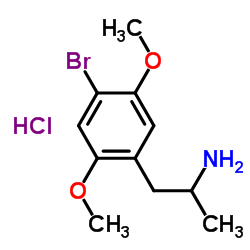A behavioral comparison of Nexus, cathinone, BDB, and MDA.
M E Bronson, W Jiang, J DeRuiter, C R Clark
Index: Pharmacol. Biochem. Behav. 51(2-3) , 473-5, (1995)
Full Text: HTML
Abstract
The effects of 4-bromo-2,5-dimethoxyphenethylamine (Nexus), 3,4-methylenedioxyamphetamine (MDA), 3,4-methylenedioxyphenyl-2-butanamine (BDB), and cathinone were studied in the newly hatched chicken and compared to the effects of d-amphetamine and three hallucinogens in the same species. Cathinone, a psychomotor stimulant in man (6), produced effects that were qualitatively similar to effects seen after administration of d-amphetamine (i.e., distress vocalization, wing extension, inability to stand, and loss of righting reflex). BDB, a compound with unknown activity in man, and two known hallucinogens, Nexus (5) and MDA (1), produced effects in the chicken that are common to both stimulants and hallucinogens in this species. For example, both MDA and BDB produced abnormal body posture that was identical to that reported after administration of hallucinogens such as lysergic acid diethylamide (LSD) and harmine (11). Nexus, on the other hand, produced rigid penguin-like posture, an effect seen in the chicken after administration of another hallucinogen, mescaline (12). BDB also produced bursting forward movements, an effect commonly observed after LSD and harmine. Our findings suggest that the young chicken can be used as an alternative, nonmammalian, model for predicting classification of new compounds.
Related Compounds
| Structure | Name/CAS No. | Molecular Formula | Articles |
|---|---|---|---|
 |
UNII:OII49KV8F3
CAS:29705-96-2 |
C11H17BrClNO2 |
|
Protracted effects of chronic stress on serotonin-dependent ...
2015-01-01 [Stress 18 , 668-76, (2015)] |
|
Beta-oxygenated analogues of the 5-HT2A serotonin receptor a...
2004-11-18 [J. Med. Chem. 47(24) , 6034-41, (2004)] |
|
A study of the metabolism of methamphetamine and 4-bromo-2,5...
2005-03-10 [Forensic Sci. Int. 148(2-3) , 131-7, (2005)] |
|
In vivo metabolism of 4-bromo-2,5-dimethoxyphenethylamine (2...
2002-03-01 [J. Anal. Toxicol. 26(2) , 61-6, (2002)] |
|
2,5-Dimethoxyamphetamine-derived designer drugs: studies on ...
2008-12-15 [Toxicol. Lett. 183(1-3) , 52-7, (2008)] |